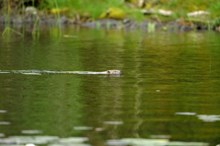17 June, 2014
New report published on Argyll’s trial beavers
The latest report looking at the trial reintroduction of beavers at Knapdale in Argyll has been published today (Tuesday17th June) by independent monitors of the trial, Scottish Natural Heritage (SNH).
The report sets out findings from the fourth year of ecological monitoring, up to spring 2013, in the five-year Scottish Beaver Trial (SBT). It is part of the SBT independent monitoring work being coordinated by SNH and will contribute to the wider programme of work being produced for the trial. The report presents the interim findings from this work. The monitoring phase of the trial concluded at the end of May 2014 and the final report, which will help Scottish Government decide on the longer term future of beavers in Scotland, is due to be published in December 2014.
The trial is run by the Scottish Wildlife Trust (SWT) and the Royal Zoological Society of Scotland (RZSS), on land managed by Forestry Commission Scotland. Since their release, SNH has been closely monitoring the beavers and their effects on the environment, in partnership with several other independent organisations.
The 15 beavers released in the first year of the trial formed five families, or pairs, and one further animal was released in year two of the trial. By June 2013, eight of the released beavers were thought to still be alive and present in the trial area, five having gone missing and three, all males, were known to have died.
Fourteen beavers are also known to have been wild-born at Knapdale by June 2013, five of which have gone missing.
The remaining beavers, which remain in four distinct family groups, appear to be healthy and have mostly put on weight since their release. The groups’ combined territory covers an area of 423 hectares, about the size of 120 football pitches, with one beaver family per 4 km of waterway edge. The report finds no evidence that the beavers have had any negative impact on otters in the area.
Jenny Bryce, wildlife ecologist with SNH, said: “It is essential that any species reintroduction project includes a properly managed and monitored trial. This means that future decisions about extending the trial or moving to full scale reintroduction are based on the best information available. The Knapdale beavers have been monitored since they were released and this work has been independently analysed. The monitoring shows us how the beavers are getting on at Knapdale and improves our understanding of how they behave in a Scottish environment. With the monitoring phase of the trial now complete, the final report due in December will be based on the five years of monitoring. This will contribute to the information provided to Scottish Government on the outcomes of the trial.”
ENDS
SNH Commissioned Report 763: The Scottish Beaver Trial: Ecological monitoring of the European beaver Castor fiber and other riparian mammals – Fourth Annual Report 2013 is available on the SNH website - http://www.snh.gov.uk/publications-data-and-research/publications/search-the-catalogue/publication-detail/?id=2146
Online copies of all SNH commissioned reports on the Scottish Beaver Trial are available at: http://www.snh.gov.uk/protecting-scotlands-nature/safeguarding-biodiversity/reintroducing-native-species/scottish-beaver-trial/the-monitoring-programme/
The Scottish Beaver Trial
For more information on the Scottish Beaver Trial visit the SWT and RZSS site at www.scottishbeavers.org.uk
The trial was set up as part of Scotland’s Species Action Framework, which set out a strategic approach to species management in Scotland. In addition, 32 species were identified as the focus of new management action for five years from 2007-2012, including European beaver. SNH worked with a range of partners in developing this work and further information can be found at www.snh.gov.uk/speciesactionframework
Monitoring the trial
The Scottish Government has asked Scottish Natural Heritage to coordinate the independent scientific monitoring of the trial and to report on whether the conditions of the licence are being fully addressed on the ground. SNH will report the outcome of the trial to Scottish Ministers. The report will also take into account other work on beavers being carried out, for example through the Tayside Beaver Group and the Beaver-Salmonid Working Group.
SNH is working with a number of independent organisations to carry out the monitoring work. They are Argyll and Bute Council, Argyll Fisheries Trust, Historic Scotland, British Dragonfly Society, James Hutton Institute, Scottish Environment Protection Agency, Royal (Dick) School of Veterinary Studies, Scottish Rural College, University of Oxford Wildlife Conservation Research Unit and University of Stirling. Each organisation is contributing resources towards the monitoring of the trial, along with SNH which is contributing £275,000. For further information on the monitoring work see www.snh.gov.uk/scottishbeavertrial
Scottish Natural Heritage is the government's adviser on all aspects of nature and landscape across Scotland. Our role is to help everyone understand, value and enjoy Scotland's nature now and in the future. For more information, see www.snh.gov.uk. SNH media is also now on Twitter at http://twitter.com/SNH_Tweets
Contact information
- Name
- Dominic Shann
- Job Title
- Media Relations Officer
- Telephone
- 01463 725157
- dominic.shann@nature.scot
NatureScot is Scotland's nature agency. We work to enhance our natural environment in Scotland and inspire everyone to care more about it. Our priority is a nature-rich future for Scotland and an effective response to the climate emergency. For more information, visit our website at www.nature.scot or follow us on X at https://x.com/NatureScot
’S e NatureScot buidheann nàdair na h-Alba. Bidh sinn a’ neartachadh àrainneachd na h-Alba agus a’ brosnachadh dhaoine gu barrachd suim a chur ann an nàdar. Tha e mar phrìomhachas againn gum bi nàdar na h-Alba beairteach agus gun dèilig sinn gu h-èifeachdach le èiginn na gnàth-shìde. Tha an tuilleadh fiosrachaidh aig www.nature.scot no air X aig https://x.com/NatureScot

